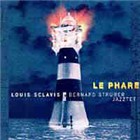Home » Jazz Articles » Album Review » Louis Sclavis / Bernard Struber Jazztet: Le Phare
Louis Sclavis / Bernard Struber Jazztet: Le Phare
Emerging on the scene in the mid-1980s, Sclavis worked with artists like Henri Texier, Peter Brötzmann, and Cecil Taylor. But while these associations would correctly suggest a penchant for free improvisation, Sclavis has always been compelled by more finely-hued structures steeped in the musical traditions of his own country and contemporary classical composition. "Manoir begins as a dark fanfare for horns, lacking any semblance of a pulse. Three minutes in it dissolves into an improvised duet for trumpet and bass. Piano and drums gradually enter, but while the piece gradually picks up steam, it remains spacious, ultimately fading to black, with a brief trumpet line signalling its end.
Elsewhere Sclavis' writing is more jazz-centric, with the swing of "Kampala supporting a characteristically knotty and rhythmically staggered melody. Sclavis has worked with larger ensembles before, but never with one possessing the Jazztet's broad textural range from gentle and warm to sharp and—often within the confines of a single piece. And while Struber's arrangements make good use of the Jazztet's greater palette, there are plenty of instances where he reduces it down to smaller subgroups.
There's an undeniable focus on Sclavis' playing, but there are plenty of opportunities for others to shine, with François Thuiller's tuba solo in the middle of "Kampala especially notable for its combination of simple lines and outré multiphonics.
When Sclavis played with his Napoli's Walls project in Victoriaville, Canada in the spring of 2004, one of the most remarkable aspects to the performance was the quartet's ability to seamlessly shift gears from unfettered free play to strict form, with cues so invisible as to seem nonexistent. Hard enough, no doubt, to pull off with a smaller ensemble like the one on Napoli's Walls, here it's even more uncanny. "Les Marches begins with a free exchange that manages to remain somehow delicate and feather-light. Suddenly, out of nowhere, Sclavis' elliptical theme bursts out over a triplet pulse from tuba and trumpet and resolves into a soprano saxophone/clarinet duet over a busy, but nevertheless insistent, percussion pulse. As the piece evolves it becomes increasingly complex and texturally rich, all the while providing space for additional improvisation.
The stylistic devices that Sclavis employs on Le Phare will be familiar to anyone who's heard any of his more recent releases. But by expanding the potential of his writing with Struber's Jazztet, Sclavis affords himself a greater opportunity for contrapuntal interaction and denser sonics, making this a worthy addition to his expanding catalogue.
Track Listing
Le Retour D'Ottomar; Le Phare; Derniers Regards; Procession; Manoir; Kampala; Les Marches.
Personnel
Louis Sclavis
woodwindsLouis Sclavis: soprano saxophone, clarinet, bass clarinet; Bernard Struber: guitar; Jean-Luc Cappozzo: trumpet, flugelhorn; Serge Haessler: trumpet, flugelhorn; Jean-Claude Eglin: trombone; Fran
Album information
Title: Le Phare | Year Released: 2006 | Record Label: Enja Records
< Previous
Metro Blue
Comments
About Louis Sclavis
Instrument: Woodwinds
Related Articles | Concerts | Albums | Photos | Similar ToTags
For the Love of Jazz
 All About Jazz has been a pillar of jazz since 1995, championing it as an art form and, more importantly, supporting the musicians who create it. Our enduring commitment has made "AAJ" one of the most culturally important websites of its kind, read by hundreds of thousands of fans, musicians and industry figures every month.
All About Jazz has been a pillar of jazz since 1995, championing it as an art form and, more importantly, supporting the musicians who create it. Our enduring commitment has made "AAJ" one of the most culturally important websites of its kind, read by hundreds of thousands of fans, musicians and industry figures every month.




















